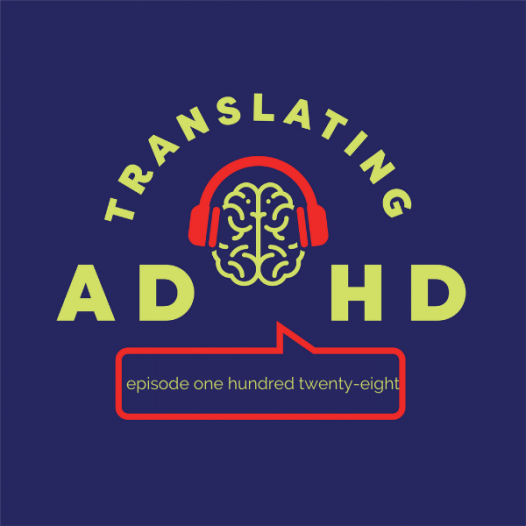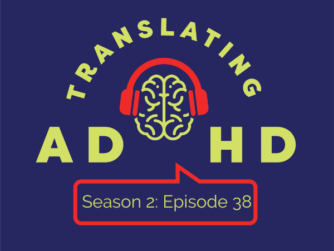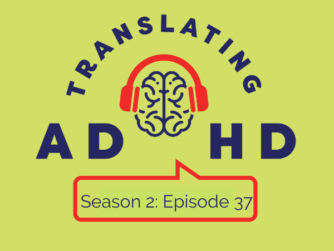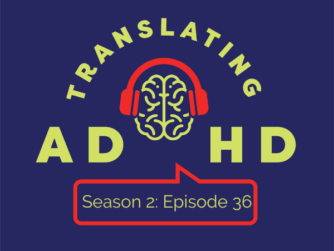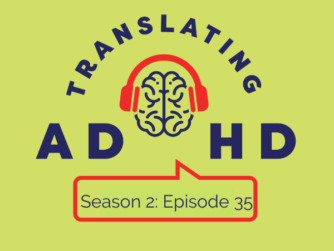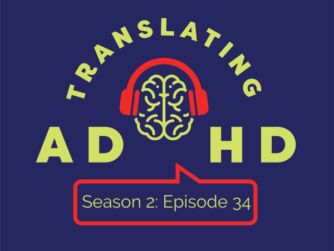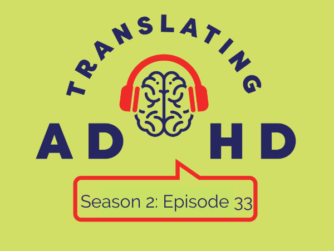Inspired by the client story from episode 127, Shelly and Cam dig deeper into the common elements the client engaged with, in part through her coaching with Shelly, to create more space, start trusting her brain and regain her own power in a difficult relationship dynamic. Cam and Shelly discuss the concept of ‘full impact’ and how those of us with ADHD can struggle to see all that is happening in our experience. This echoes First Barrier dilemmas (Barrier to Awareness.) Cam draws in the four elements of emotional intelligence and how getting to awareness and then management with self (introspection/reflection) and our social environment (perception) can be fraught with mis-information and stories that make seeking the truth challenging. Distinguishing what is real and what is not real is an early step to creating the space for informed and empowered change.
Both Shelly and Cam discuss the power of one’s own context and how it relates to activating curiosity and creativity (Cam’s boat in a lake metaphor) and journey thinking (Shelly’s pond metaphor). They also discuss how detaching from outcome and discerning ‘Mine’ from ‘Ours’ can create a context or frame for a place to start seeing the full impact of our experience.
Episode links + resources:
For more of the Translating ADHD podcast:
- Episode Transcripts: visit TranslatingADHD.com and click on the episode
- Follow us on Twitter: @TranslatingADHD
- Visit the Website: TranslatingADHD.com
Episode Transcript:
Shelly: Hi, I’m Shelly.
Cam: And I’m Cam.
Shelly: And this is Translating ADHD. Real quick, we have two group coaching offerings out there right now available for you to apply to the first is our translating ADHD resilience course, which begins Wednesday, June 22nd and meets at 8:30 PM Eastern. The second is an advanced offering with Cam and that one is equanimity that begins Tuesday, July 20 and begins at 9:00 PM Eastern. For information on both of these courses, including pricing and details and how to apply, visit the website translatingadhd.com and click on group coaching. So Cam, what are we diving into today?
Cam: I was inspired by your client. Last week we were talking about your client recognizing that she couldn’t trust her brain in her relationship. That was not healthy. And so listening to the episode and reflecting on it, I was thinking about the amazing work that she did and that how, all of that. Can take what she did, because what she did was to create space for herself in this very difficult environment. She created contexts that worked for her. She got clear on a coaching goal. of moving to an informed choice about whether to stay in the relationship or not stay in the relationship, but realizing the first step there or multiple steps was to reconnect with her brain to trust her brain again. It was really inspiring. And I think that there’s some common elements that she used that you used with her, that all of us can benefit from. And I think that the working title today is orienting to the full impact of our experience, that it’s. Really recognizing what’s the impact here and that she got to that point.
ADHD can make it really difficult to get to the reality of what is going on, because as you said, we can exacerbate or elevate our own challenges. We can downplay. The challenges that are around us. If it’s in a gaslighting partner is last week or a work situation, that’s not tenable. Conversely though, I have people who come to me and they think, I’m here because of my spouse and I don’t know what the big deal is. And they will downplay the situation. They will downplay their own impact. You know, this will pass. And so it’s getting an accurate reading and getting closer to an orienting to what is actually happening. If you were to Google emotional intelligence four box quadrant there, I think that in the upper you think about it, it’s a breakdown between self and social awareness and management, right? So the upper left-hand box is self-awareness the upper right-hand box is social awareness. And then drop down below. The self-awareness one it’s self-management and then the final box in the lower right is social management. You start in the upper left, you have to start with self-awareness in order to get to social management, to manage being in your environment. And so ADHD impacts our ability to develop effective emotional intelligence, just because our story is kind of screaming at us and we’re not getting an accurate read on the situation.
So the thing that I noticed last week, Shelly, was your client started to question the story, the pervasive story in her brain, just to get curious. Is it accurate? What is accurate about it? What’s not accurate about it and not bringing fear as the leading mechanism, because again, fearful of not being successful in a relationship, like you said, death do us part. So it’s like, got to make this work because I took it a vow. And fear of losing something so we can start there and right in there. And that fear center is that inner critic who is commenting and narrating all the time, whispered in our ears. So she was able to orient to that to recognize it. Wasn’t the reality. It’s a story that’s informing based in some So getting to the truth is a process that is really worthwhile as you start to understand own and translate your own ADHD experience.
Shelly: Cam I think it’s important here to even go all the way back to before the marriage entered the coaching and the fact that we were a little stuck and we were a little stuck because we weren’t coaching to the thing, having the biggest impact and not because the client was intentionally trying to hide the biggest impact. She simply wasn’t aware that that’s where the impact was coming from until she was until she did bring it to a coaching session, Cam. And I talk a lot about detaching from outcome as a coaching philosophy. And one of the biggest reasons that’s so important is I could have never known that the reason that we were stuck was this whole other area of impact going on with my client.
I knew we were stuck. I knew there was something else we needed to uncover or get to that we hadn’t found. But I wasn’t attached to what that was because what’s there in those places for every client is different. This is the stuff of your context matters. And for this client, there’s this whole context of a marriage that isn’t working.
And one that is impacting her in a number of ways. And this belief, her story, that it’s her ADHD getting in the way, which it was in part, but it wasn’t an either-or situation. It was both things together. And so just to even get to the part where we could start building awareness about this, we first had to uncover that it was there and that all of these impacts that she was experiencing were coming in part from this dynamic in this situation. And that was something that was invisible to her until it wasn’t.
Cam: So well said, just so many different client examples, including my own experience here, right. There was sort of the age of ambivalence of Cam. I didn’t know what I didn’t know, because I didn’t know the true impact because the signals that I was paying attention to were inside my head informed by my experience. But this narrative of you don’t belong here. You somehow snuck by ticket booth. And so with that as a pervasive narrative, it’s really hard to get to the actual data of what is happening. So in coaching, what we often do. Is that we are curious about the client’s context, right? So as Shelly said, we are detaching from outcome number one, number two, we’re super curious about what else might be going on and not with suspicion, but with curiosity, so we go back to the lunch counter and how.
That prescriptive approach to ADHD is very limited. it’s a starting place, right? but it, doesn’t have legs because your context is unique to you. And here’s this how your ADHD and your wiring integrates with your experience. Kind of what kind of work environment are you in?
Do you have people who are supportive or do you have a situation where it doesn’t matter what you do with your ADHD? It’s not possible to have to be succesful. Again, back to that grid of the emotional intelligence. We have to work a little extra to get to that self-awareness place to get to the social awareness of what’s happening around me to develop that awareness and then the management aspect. So that awareness management between the self and the social is all about the three barriers of ADHD, right. Is that first barrier to awareness, the second barrier to action. That’s the management aspect. And then the feedback loop to carry it forward is the third one of taking the hard learning and applying it forward.
The so fascinating is that in every single one of our group coaching classes, and we’re doing project X right now last week, we just talked about. Taking their experience, regardless whether they’re successful or not, and pulling out the learning and applying it forward. So that’s about exercising, this awareness muscle and this management muscle. just because it’s hard doesn’t mean we can’t do it. Shelly and I would not be here if it was Impossible. It is possible. And when you start to focus on context and bring some curiosity, then you can start to get creative and actually have a little picture. I may have shared this before, but I’m going to bring it back.
I just shared this with a client last week. So when people are asking listeners like context, you keep bringing up context. What does that mean? We often say we’re wired for context, we’re wired for connecting with our environment, but we’re taking cues from our environment sometimes, and we’re not aware of it responding to reacting.
Right. Getting in that defensive crouch. To a situation that’s on the outside and yet we’re not able to see actually what’s going on. So context is know, imagine if you’re in a little boat in the middle of the Atlantic and a swell, that’s pretty sketchy, right? You’re sitting in a little, aluminum fishing boat, no land, you see nothing. And there’s a swell it’s disorienting. No landmarks, but imagine now, if we were able to kind of think of a shoreline that we could define the edge of that body of water, right? It’s a lake good size, but you can see the shoreline all the way around. How do you feel in that boat now? With that orientation or orienting to landmarks. This is so important for us with ADHD, because with ADHD, it is a structural phenomenon, right? That some assembly required of building out our framework to orient, to our social situations, our environments, our sense of self and seeing ourselves in the picture. So we talk about seeing ourselves in the picture. Context is part of that picture. But when you can start to define or frame out where our boat is, that’s context, you can get that a reliable motor on the back of that boat. I only can move, push that boat, drive that boat around that lake that’s curiosity, right to curiously explore. In this area, if it’s too small, expand the lake, if it’s too large, bring it in the sense of my work, this project, this aspect of my relationship define to orient you can’t orient, unless you define. Finally, if you’re doing that to some degree, and this is the interesting thing that happens in coaching is as we kind of create our frames of context and we explore these frames with curiosity, that’s when we put the tow rope out for the skier and that’s creativity, we get into sort of creative work. Of it’s a playful element. It’s not that it’s not serious. It’s very relevant, but that creativity and that curiosity lives in the other side of the brain away from that fear and urgency place. And this is spacious. That’s the thing I want to come back to last week with your client, Shelly, was that she had a spacious approach to this. She was doing some skiing with you to look at this, to regain her power and develop some agency.
Shelly: Cam you talk about that spaciousness? And again, this comes back to detaching from outcome. The outcome that we anchored to with that client had to do with trusting her own brain and strengthening herself things completely within her control. What she was letting go of and decoupling from is the outcome of the relationship.
Put her focus inward on herself and on my stuff. And wasn’t attached to where that would lead. And this brings us back to the idea of journey thinking why the coaching clients that really benefit the most from coaching are the ones that we’re able to invite into this perspective. My favorite metaphor on journey thinking I’ve said it before on the show, but it’s been awhile.
So I’ll say it again. Is this idea that you’re standing on a stepping stone on a really foggy pond and there are stepping stones in all directions, but it’s so foggy that you can barely see the stone you’re on and you can’t see where the stones that you can reach next are what they are. And that right there is the idea of journey thinking this client let go of, I need to save this relationship, or I need to X this relationship or whatever else.
And instead oriented to the learning as a goal, trusting my own brain, strengthening myself and seeing what stepping stones that revealed for her. And when a new one was revealed, we’d step on it. And we get curious there because the goal was no longer to get to shore, to get to somewhere with the relationship itself. The goal became the learning and the curiosity and how that itself might become our guide showing us which stepping stones to go to next.
And for comparison sake, Cam, let’s talk about another client who has some relationship challenges, but very different challenges. One of the big problems for this client is discussing contentious topics with his partner very early on. When we were working together, we noticed that he would get into this defensive place before the conversation even began. And he would take on all the blame and the sense of responsibility for fixing whatever was causing the dilemma. So right there was that first important awareness is we knew what the impact was that these conversations were yucky and could knock my client off of his game for days or weeks at a time. But what he wasn’t yet aware of is how he was showing up in those conversations, this defensive posture, coupled with this blame sponging, that’s the client. I actually coined the term blame sponge with. So in recognizing that much, then it became about changing the defensive crouch into something more constructive. And being able to distinguish in those moments, what’s his stuff and what’s not his stuff. Being able to detach from his partner’s anxiety, recognizing that how she’s showing up is part of the dynamic, but that doesn’t mean it’s his fault. That it’s part of the dynamic and he doesn’t have to attach to it as being his fault.
And so here again, a situation where the client and I worked completely in the realm of his stuff, but he’s showing up differently in these conversations. Now he knows what his boundaries are. He knows what’s his. To take on in terms of my fault, my stuff and what he can let go of. And because he’s having a different experience in the conversation and not getting drugged down so far into the valley, he’s walking away, not being knocked off his game for days or weeks at a time he’s able to recover and move on. To climb out of that valley quickly. If he even ended up there at all in the first place.
Cam: What I like about that example is again, back to seeing oneself in the picture. use that as a positive term to see yourself in your picture. But I would say that it’s taking ownership of his own behavior. In that picture or in that specific context, right. in this dynamic with his partner and how he’s showing up.
And it’s sorta like, again, to be able to turn on the spicket a little bit let that reality seep in to see yourself and how you’re showing up and how it may not be working for the situation. this is bringing compassion. It’s bringing curiosity. It’s bringing empathy with this larger context of we’re trying to improve here.
Right? This is about positive change. And so often it’s like give us the tools. I really don’t want to look at the blemishes. And unfortunately you got to start with. Everything to look at that and in order to distinguish your own behavior, what’s mine versus what’s. Ours is to look at the mind part of the positive and the not so positive and to own it and not to make meaning there of what it means in the sense of that it means more, right. I am to blame. No, it’s just to behave. You’re trying to protect yourself and we do what we need to do. These are coping mechanisms for years and years of living with this thing. We didn’t know we had give yourself some grace, but as you start to, I love, again, the context here is around learning.
What can I learn from this? There’s that contextual. shoreline, if you will. And in that context, we can get really curious and be creative about where we place those river rocks. Just to help the resist bringing in your metaphor in my metaphor together. Can’t resist. I just can’t.
Shelly: Give Cam two metaphors and a blender, man.
Cam: Puree smoothie anyone?
Shelly: Cam as often happens on this show, I’m realizing that there’s more to say about impact than we’ve been able to say today, orienting to that impact where it’s coming from, what’s it caused there. What’s the real impact here? How is it affecting me? There’s more here, and so we’re going to jump right back into this next week.
So listeners, yet again, great opportunity here. With your stuff, my stuff, our stuff, put yourself in that picture. Notice what impacts a dynamic might be having on you. And remember, this is not about all or nothing. I have a great relationship with my partner being in that relationship has impacts and has impacts that I need to figure out for myself. And then they’re not always so clear and obvious. Orient to where’s this impact coming from, I feel this way, or there’s the strong emotion or strong signal? Where is that really coming from? And if it’s coming from a dynamic with another person, yours, mine, ours is a great way to start. What’s my stuff. And if I only have control and leverage over my stuff and nothing else changes, what does that do?
And if you don’t know the answer to that question, start working on your stuff and see what happens if possible, invite the other person into work on our stuff. But if not, keep working on your stuff. Don’t worry about getting to shore, keep uncovering those stepping stones and let that inform your choice rather than trying to hypothesize first about what that choice might be.
So, if you like what we’re doing here on the show, three big ways you can help us out. Going to keep it short and sweet today because you already know them. The first is leave a rating or review wherever you listen. Please and thank you. The second is don’t keep us a secret, share us on social and in the neurodivergent groups that you are in. And finally, you can financially support us by becoming a patron. Visit the website, translatingadhd.com, click on the Patreon link in the upper right-hand corner, and for five bucks a month, you’re not only helping Cam and I cover all of the administrative costs of running this show, you also gain access to our discord community where our listeners are working together to do their own understand, own and translate work.
So until next week, I’m Shelly and this was the translating ADHD podcast. Thanks for listening.

